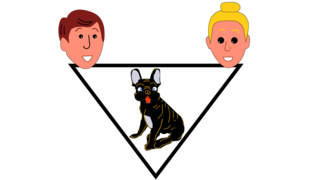Animal Behavior
Does Your Pet Play a Therapeutic Role in Your Relationship?
Pets open emotional space in a unique way that can improve couple relationships.
Posted January 3, 2022 Reviewed by Michelle Quirk
Key points
- Pets play a therapeutic role in couple relationships by expanding perspective, potential. and possibilities.
- In an uncanny and unique way, pets seem to serve as "the third"—what Dr. Lewis Aron describes as the position of a couple's therapist.
- In the role of the "third," pets expand the couple's vantage point from an up-and-down see-saw of complementarity to open, hopeful perspective.
In addition to all the positives that pets provide, a close look reveals they have the potential to play a therapeutic role in a couple’s relationship. In an uncanny and valuable way, pets seem to serve, much like a therapist, as the emotional “third” to a couple. As such, they open emotional space to new perspectives and options for relating.
Katie and Rob, a couple in a second marriage for both, never planned to have a pet. They cautiously agreed to take Penny, a little terrier, when a relative became sick. Of course, they fell in love with her. When I asked them how Penny had impacted their relationship, their answer surprised me:
Penny is our peacemaker. Before Penny, we would stonewall each other and not speak for days after an argument. It is funny what happens now—after an argument, one of us will start talking about Penny to the other to break the ice. We never planned it—we just do it and it works.
In some ways, Penny had become the “third” in their relationship.
The Concept of the “Third”
The concept of the “third” comes from relational psychology, specifically the work of psychologist Lewis Aron, author of A Meeting of Minds: Mutuality in Psychoanalysis (1996), who resonated with the work of Jessica Benjamin (1999), and recognized the intersubjectivity or shared psychology of a couple (i.e., their tendency to get locked into complementary and often destructive positions).
Aron conceptualizes this as the couple sitting on a see-saw, stuck at opposite ends and in complementary positions—as victim–victimizer, giver–taker, winner–loser, etc. As such, they may move up and down in terms of their own perspective, needs, or opinions—but actually go nowhere. The presence of the therapist as “the third” opens the space to a triangle and possibility.
In clinical work, the therapist as the "third” is particularly useful in understanding and resolving impasses and conflicts. Often the space opened by the therapist as the “third” makes possible recognition of the complementarity of couple’s positions on the see-saw. They are able to recognize and see each other in a different space and from a different perspective.

Your Pet as the “Third”
A close look at partners and their pets invites us to consider that, in an unexpected and uncanny way, pets also can serve as the "third."
They open the space between and within partners in therapeutic ways that invite mutual focus and room to move closer in emotional space. Consider these situations:
Opening the Space to Share
Moving to a new city for David to take a new position that involved travel was not a first choice for Mary. It was difficult enough for her to find a new job, much less a connection. Clearly, after a month, the decision was not sitting well between them. Mary began seeing David as more selfish than she had realized: “Did he know how much this move cost me?” Feeling her cool annoyance, David felt alone with his worries about succeeding and fatigue from constant traveling in the new position.
Enter Wilbur, a tiny black French bulldog with big potential to fill the gap. Not only did Mary feel comforted by her little companion when David was away, but both David and Mary were also delighted to find neighbors who, initially polite, became enthusiastically welcoming once Wilbur arrived and the three were out walking. Feeling the benefits of emotional regulation provided by the mutual love for Wilbur and the regular opportunity for walking and talking together, both David and Mary used the space to share the loneliness and fears they were each holding alone. Wilbur had bridged the gap and opened a way to find each other again.
From Rigid Rejection to Flexible Reconnection
Married four years, Casey and Mike were lonely and unhappy in a sexless marriage they each blamed on the other. She claimed he loved time with his buddies much more than time with her, and he insisted her cool indifference pushed him away. Neither could self-reflect on the role they played in their failed connection.
When neighbors who had to relocate asked if they would consider adopting two little kittens, Casey and Mike agreed in a rare moment of mutuality. Both were moved by the other's positive response. From naming to sitting with these tiny pets, their shared focus was an opportunity to experience each other’s presence and tenderness without judgment or rejection.
In a different and unexpected space, the little pets afforded glimpses of the other they had loved and lost.
A New Way of Knowing
One of the problems with partners who are struggling is their assumption that they really know the other—an assumption that often precludes the possibility of knowing more.
As such, a powerful and poignant dimension of couple therapy is each partner’s observation of their partner in exchange with and in the eyes of the couple therapist. Sometimes partners are shocked by revelations of hopes and dreams, glimpses of personality, disclosures of historical pain, and affirmations of love—rarely voiced and rarely heard.
An Expanded and Appreciative View of Each Other
Admittedly with a little less clinical skill, one similar way that pets serve as the "third" to their couple is by expanding the way the partners see each other. The view from across the yard of partner with pet is often a view from an unexpected vantage point that enhances or rekindles respect, love, and connection.
When I saw the way that man loves and carries my old Lab, I remembered why I loved him.
We were both caught off-guard when we entered the living room to realize that the cats had decorated the place with toilet paper. When we laugh like that, it brings us back to who we are.
When the dog comes bounding with love and enthusiasm onto our bed, I am struck with how often we take each other for granted.
It seems we cannot underestimate the therapeutic potential of finding the best of each other through our pets.




